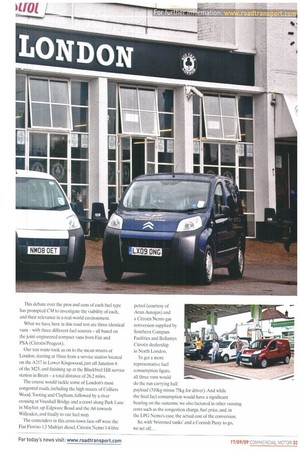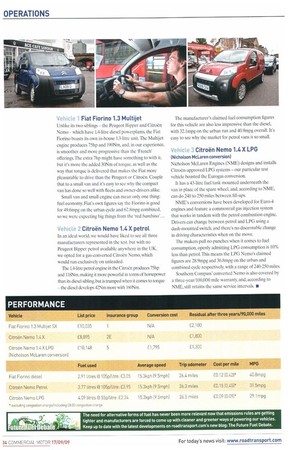Take three small vans with three different fuel types and
Page 32

Page 33

Page 34

If you've noticed an error in this article please click here to report it so we can fix it.
drive across London to see which is the most cost-effective in terms of consumption. It's LPG versus petrol versus diesel.
Words: tan Tonkin , Matcolm Case-Green When it comes to commercial vehicles, diesel is the default fuel of choice. After all, it's available on just about every street corner, and, in general, offers the best fuel consumption of all mineral fuels.
But it might not have escaped your notice that there are a variety of alternatives to diesel ranging from electricity to LPG. and each with its own benefits.
What about unleaded petrol? It, like LPG, is cheaper than diesel, but lacks the environmental credentials of gas and the fuel economy of diesel. OK, it may not stand up when applied to larger CVs, but at smaller capacities, the extra consumption can be negligible.
This debate over the pros and cons of each fuel type has prompted CM to investigate the viability of each, and their relevance in a real-world environment.
What we have here in this road test are three identical vans with three different fuel sources all based on the joint-engineered compact vans from Fiat and PSA (Citroen/Peugeot).
Our test route took us on to the mean streets of London, starting at 10am from a service station located on the A217 in Lower Kingswood, just off Junction 8 of the M25, and finishing up at the Blackbird Hill service station in Brent a total distance of 26.2 miles.
The course would tackle some of London's most congested roads, including the high streets of Colliers Wood,Tooting and Clapham, followed by a river crossing at Vauxhall Bridge and a crawl along Park Lane in Mayfair. up Edgware Road and the A6 towards Willesden, and finally to our fuel stop.
The contenders in this cross-town face-off were the Fiat Fiorino 1.3 Multijet diesel, Citroen Nemo 1.4-litre petrol (courtesy of Arun Autogas) and a Citroen Nemo gas conversion supplied by Southern Compass Facilities and Bellamys Citroen dealership in North London.
To get a more representative fuel consumption figure, all three vans would do the run carrying half payload (310kg minus 75kg for driver). And while the final fuel consumption would have a significant bearing on the outcome, we also factored in other running costs such as the congestion charge, fuel price, and, in the LPG Nemo's case, the actual cost of the conversion.
So. with 'brimmed tanks' and a Cornish Pasty to go, we set off...
Vehicle I Fiat Fiorino 1.3 Multijet
Unlike its two siblings the Peugeot Bipper and Citroen Nemo which have 1.4-litre diesel powerplants, the Fiat Fiorino boasts its own in-house 1.3-litre unit.The Multijet engine produces 75hp and 190Nm, and, in our experience, is smoother and more progressive than the 'French' offerings. The extra 7hp might have something to with it, but it's more the added 30Nm of torque, as well as the way that torque is delivered that makes the Fiat more pleasurable to drive than the Peugeot or Citroen. Couple that to a small van and it's easy to see why the compact van has done so well with fleets and owner-drivers alike.
Small van and small engine can mean only one thing: fuel economy. Fiat's own figures say the Fiorino is good for 49.6mpg on the urban cycle and 62.8mpg combined. so we were expecting big things from the 'red bambino'...
VehicLe 2 Citroen Nemo 1.4X petrol
In an ideal world, we would have liked to see all three manufacturers represented in the test, but with no Peugeot Bipper petrol available anywhere in the UK, we opted for a gas-converted Citroen Nemo, which would run exclusively on unleaded.
The L4-litre petrol engine in the Citroen produces 75hp and 118Nm, making it more powerful in terms of horsepower than its diesel sibling, but is trumped when it comes to torque the diesel develops 42Nm more with 160Nm. The manufacturer's claimed fuel consumption figures for this vehicle are also less impressive than the diesel, with 32,1mpg on the urban run and 40.9mpg overall. It's easy to see why the market for petrol vans is so small.
Vehicte 3 Citroen Nemo 1.4X LPG
(Nicholson McLaren conversion) Nicholson McLaren Engines (NME) designs and installs Citroen-approved LPG systemsour particular test vehicle boasted the Eurogas conversion.
It has a 43-litre fuel tank mounted underneath the van in place of the spare wheel, and, according to NME, can do 240 to 250 miles between fill-ups.
NME's conversions have been developed for Euro-4 engines and feature a commonrail gas injection system that works in tandem with the petrol combustion engine. Drivers can change between petrol and LPG using a dash-mounted switch, and there's no discernable change in driving characteristics when on the move.
The makers pull no punches when it comes to fuel consumption, openly admitting LPG consumption is 10% less than petrol. This means the LPG Nemo's claimed figures are 28.9mpg and 36.8mpg on the urban and combined cycle respectively, with a range of 240-250 miles.
Southern Compass' converted Nemo is also covered by a three-year/100,000 mile warranty, and, according to NME, still retains the same service intervals. •








































































































































